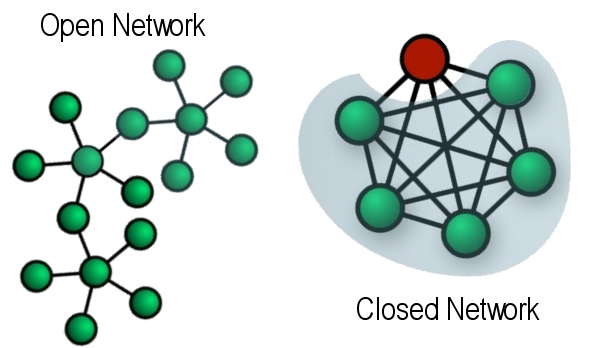Internet plays an indispensable role in today’s society. From birth to now, it has continuously penetrated into various industries and has become the most important part of contemporary social technology and economic development. Therefore, Internet always gives people the characteristics of openness. But apart from the open network, there is the closed network that we rarely know. Let’s start by defining the two networks and make open network vs closed network to see which is more in line with people’s needs.

What Is an Open Network?
An open network can have many definitions depending on different requirements. An open network can refer to a network that must conform to open industry standards. Whether the device is used to interact within a network or externally, an architecture that is open every step of the way is needed. An open network can represent a network with an open ecosystem that defines the deployment scope of the solution set. An open network can mean an open source network that enables innovation in the marketplace while ensuring that the resulting product is constantly secured by the community that is contributing to it. An open network can indicate a network that provides access to the infrastructure in a programmable way through APIs (Application Programming Interfaces). However, those APIs are often closed out or only work with their solution. In summary, an open network allows a variety of entities to provide service on a reasonably equal basis versus each other and the network operator.
What Is a Closed Network?
Likewise, a closed network also has different meanings. A closed network can refer to a private telephone network that has no external (public switched telephone network) connectivity. A closed network can imply a network that uses proprietary technology which is not directly interoperable with other standards-based networks. A closed network can signify a WLAN that does not send its name (SSID) in beacon frames. Stations must know the SSID (Service Set Identifier) in order to connect to access points in that network. A closed network can represent a private network that can only be used by authorized devices. Outsider use is prohibited and enforced through cryptographic means. In short, a closed network is one that sets aside a great deal of the network capacity for a limited set of providers, usually but not always limited to the network provider.
Open Network vs Closed Network
From the above, we know how to define open and closed networks from different aspects. Here we list three different network environments. Take the forth definitions of open and closed networks as an example to compare and choose the network that works best for you.
Business Network
We know that all businesses depend on information flow. A closed network allows information to move freely within the business. And under the transparency provided, managers can directly know the situation and better guide the team’s work. The closed network also supports the need for privacy. Private messages can be sent to specific audiences, and private groups can be created for sensitive, ongoing conversations. Many closed networks provide “external network” capabilities that allow employees to connect outside partners, advisers, consultants, vendors, and suppliers. However, an open network allows employees to view more information, and when employees have the information they need, they make better decisions and are more productive. But in terms of privacy, an open network makes company information public and does not effectively protect the company’s core secrets.
Home Network
With the popularity of wireless networks, many houses are equipped with a wireless network. But is it okay to have an open home network? Not really. Having an open home network can be a security risk as it may allow anyone close enough to your router (e.g., a neighbor or war driver) to access your network and steal your personal information. In this case, a closed network will make your home network more secure.
Social Network
Essentially, social network is a broadcast distribution system designed to share as widely as possible. An open network means sharing with everyone and encourages open behavior. Participants simply “put it there” and less worried about individual reactions. Whereas a closed network means sharing is limited to selected people, interaction only happens between people who have specifically chosen to do so under a mutual trust. If the trust is broken, just rescind the interactive permission. The best social network depends on what the marketing professional is trying to achieve. To grab attention, fast and broad sharing open network is the best. If the idea is to create deeper engagement, then trust is more important, a closed network is more suitable.
Conclusion
Both open network and closed network provide unique value and can be used in different ways for the success of the network. They are widely used in network switches (e.g.,10gb switch). If you have figure out the difference between them, you can start building the network you need.
Related Articles:
FS Optical Transport Network Platform Unveiling
Open Network Linux: A Change Agent For Innovation
